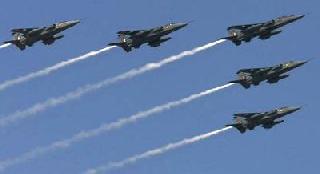
Airman 1st Class Patrick Connolly of Dayton, Ohio, demonstrates the placement of a water disruptor developed at Sandia National Laboratories near its target in a simulated village used to train soldiers heading overseas. Photo by Randy Montoya.
LONDON (PTI): US soldiers fighting the Taliban in Afghanistan will soon take help of a new device that shoots a blade of water to destroy improvised explosive devices or IEDs -- the biggest killer of troops and civilians in the war-ravaged country.
The device called 'The Stingray' is filled with water and an explosive material which -- when detonated -- creates a shockwave that travels through the water and speeds it up, creating a thin, powerful blade of water capable of penetrating steel.
Developed by Sandia National Laboratories, the gadget uses minimal explosive material. Its plastic legs can be attached in various configurations so that it can be placed in different positions to disable bombs and it's built so that robots can easily place it near a target.
About 3,000 units of the device are heading out to US soldiers in the region this year, the Daily Mail reported.
Greg Scharrer, manager of the Energetic Systems Research Department at Sandia, said: "The fluid blade disablement tool will be extremely useful to defeat IEDs because it penetrates the IED extremely effectively.
"It's like having a much stronger and much sharper knife."
Unlike traditional explosives, which release energy equally in all directions when they go off, researchers used shaped-charge technology in this new gadget to deliberately manipulate the explosives.
This means they can create a certain shape when they explode, allowing the operator to focus the energy precisely where it is needed to create the 'blade' of water.
Steve Todd, a mechanical and materials engineer with extensive Navy experience fighting IEDs, said: "That allows you to have a high-speed, very precise water blade to go through and do precision type of destruction on whatever improvised explosive device it’s going up against.
"Immediately behind the precision water blade is a water slug, which performs a general disruption that tears everything apart."
"We're putting the explosive in a flat tray and we're shaping the water," Scharrer said.
The basic concept of the devices was first developed in the 1970s in Britain to deal with IRA explosives, but has been refined over the years.
Researchers used computer simulation and high-speed flash X-rays, which can look inside imploding high-explosive devices, to fine tune the design.
The company's first priority is to get the device to troops in Afghanistan, Taliban insurgents have killed or injured at least 7,000 Afghan civilians in IED attacks between 2004 and 2009.
However, the company plans to sell it to law enforcement and airport security agencies. The device also could be used for forced entry into buildings.
 Previous Article
Previous Article Next Article
Next Article












The Indian Air Force, in its flight trials evaluation report submitted before the Defence Ministry l..
view articleAn insight into the Medium Multi-Role Combat Aircraft competition...
view articleSky enthusiasts can now spot the International Space Station (ISS) commanded by Indian-American astr..
view article